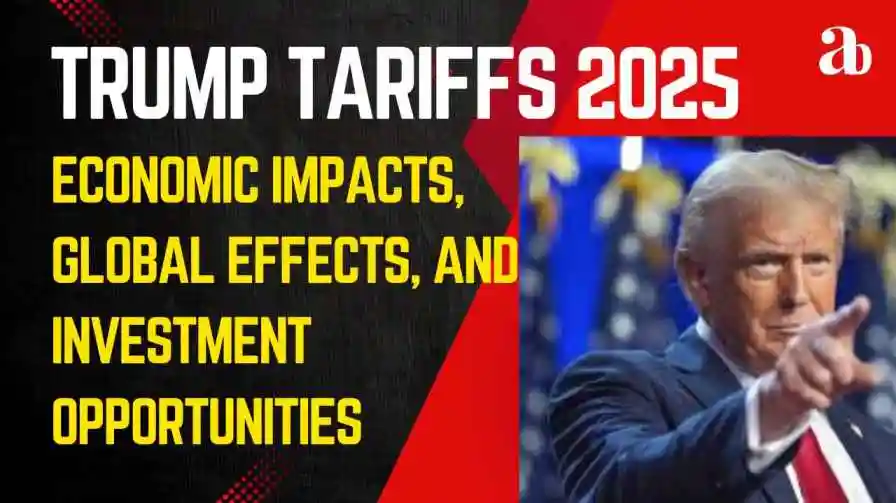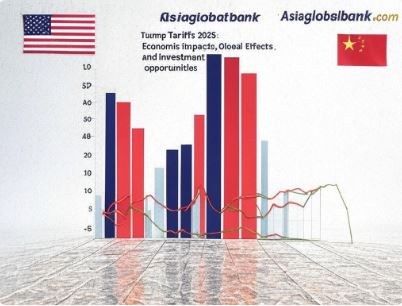Trump Tariffs 2025: Economic Impacts, Global Effects, and Investment Opportunities– President Donald Trump’s trade policies are reshaping the global economy in April 2025, with a 10% baseline tariff on imports and a softened stance on China tariffs driving both uncertainty and opportunity. These Trump tariffs 2025 are influencing consumer prices, business strategies, and financial markets. This in-depth guide, featuring data tables, explores the tariffs effect on economy, global implications, and actionable investment strategies. Asiaglobalbank.com provides expert insights to help you navigate Trump trade policy 2025.
What's Next
ToggleUnderstanding Trump Tariffs 2025
On April 5, 2025, the U.S. imposed a 10% tariff on affected imports, raising concerns about trade wars and inflation. However, Trump’s April 23 announcement of reduced tariffs on Chinese goods—“coming down substantially, but not to zero”—has eased some fears, as reported by CNN. Chinese social media platforms like Weibo trended with hashtags like “Trump chickened out,” reflecting global attention. These tariffs aim to boost U.S. manufacturing but risk disrupting supply chains and raising costs. For investors and businesses, understanding these shifts is key to thriving in stock market tariffs in 2025.
Economic Impacts of Trump Tariffs 2025
The tariff’s effect on the economy spans consumers, businesses, and markets. Below, we break down the impacts, with a table summarizing affected sectors.
1. Consumer Prices and Inflation
Tariffs raise the cost of imported goods, impacting electronics, clothing, and more. Apple’s airlifting of iPhones from China in early April to avoid tariff costs highlights supply chain challenges. Analysts predict a 2-3% price increase for consumer goods by Q3 2025, potentially driving inflation. Selective exemptions for tech components may mitigate some effects, but middle- and low-income households face tighter budgets.
2. Business Challenges and Opportunities

Businesses face higher costs and uncertainty. American Airlines withdrew its 2025 forecasts due to tariff-related risks, while small businesses struggle with squeezed margins. However, domestic manufacturers like U.S. Steel are seeing increased orders as tariffs favor local production. The table below outlines key sectors impacted by tariffs.
| Sector | Challenges | Opportunities |
|---|---|---|
| Retail | Higher import costs, reduced margins | Shift to domestic suppliers, e-commerce growth |
| Manufacturing | Supply chain disruptions, raw material costs | Increased U.S. production, government incentives |
| Technology | Tariffs on components, price hikes | Exemptions for key parts, nearshoring to Mexico |
| Agriculture | Retaliatory tariffs from EU, China | Domestic demand growth, export diversification |
3. Stock Market Volatility
The stock market tariffs 2025 narrative has fueled volatility. Tech stocks dipped in early April, while airline stocks faced pressure. Trump’s softened China tariff stance on April 23 sparked a 1.2% S&P 500 rally, per Yahoo Finance. The table below shows market reactions.
| Index/Stock | April 5 (Tariff Imposed) | April 23 (China Tariff Relief) |
|---|---|---|
| S&P 500 | -0.8% | +1.2% |
| Nasdaq | -1.1% | +0.9% |
| Apple (AAPL) | -1.5% | +1.0% |
| U.S. Steel (X) | +2.3% | +0.5% |
Global Implications of Trump Tariffs 2025
The China tariffs impact on 2025 reverberates globally, affecting trade and investment. Here’s how key regions are responding.
1. Asia-Pacific Markets
China’s exporters are diversifying to Vietnam and India to offset tariff losses, while South Korea’s semiconductor industry benefits from potential exemptions. Reduced China tariffs could stabilize Asian markets, boosting confidence in regional ETFs.
2. European Union
The EU is preparing retaliatory tariffs on U.S. goods like whiskey and agricultural products, straining transatlantic trade. However, European renewable energy firms may gain from localized production incentives.
3. Emerging Markets
Mexico and Brazil are attracting investment as nearshoring hubs. Mexico’s manufacturing sector, in particular, is thriving due to its proximity to the U.S., making it a focal point for investors.
Investment Opportunities Amid Trump Trade Policy 2025
Tariffs create risks but also opportunities. The table below outlines recommended investments for Trump trade policy 2025.
| Asset/Sector | Why Invest? | Potential Return (2025) | Risk Level |
|---|---|---|---|
| Domestic Manufacturing (e.g., Nucor, Ford) | Tariffs favor U.S. production | 10-15% | Moderate |
| Cryptocurrency (e.g., Bitcoin ETF) | Hedge against volatility: Bitcoin at $92,410 | 20-30% | High |
| Renewable Energy (e.g., First Solar) | Domestic production incentives | 8-12% | Low-Moderate |
| Emerging Market ETFs (e.g., EEM) | Stabilized China trade | 12-18% | Moderate |

Diversifying across these assets—balancing high-risk options like crypto with stable sectors like renewables—can optimize returns while managing tariff-related volatility.
Practical Steps for Businesses and Investors
To navigate Trump tariffs 2025, follow these steps:
- Track Policy Updates: Monitor U.S. Trade Representative announcements and X hashtags like #TrumpTariffs2025 for real-time insights.
- Optimize Supply Chains: Shift to domestic or nearshore sourcing, as Apple did with airlifts.
- Hedge Volatility: Use options or ETFs to protect against market swings.
- Use Financial Tools: Leverage Bloomberg or Morningstar for tariff impact analysis.
Why Asiaglobalbank.com Is Your Go-To Source
Understanding Trump’s trade policy 2025. Asiaglobalbank.com offers daily finance news, trade policy updates, and investment strategies. Subscribe to our newsletter for exclusive reports on China tariffs impact 2025 and follow us on X (@Asiaglobalbank) for market insights.
Trump tariffs 2025 are reshaping global trade
The Trump tariffs 2025 are reshaping global trade, with impacts on consumers, businesses, and investors. While challenges like inflation and supply chain disruptions persist, opportunities in domestic manufacturing, cryptocurrency, and emerging markets offer significant potential. The data tables above provide a clear roadmap for navigating these changes. Stay ahead with Asiaglobalbank.com, your trusted source for finance and economic news.


 Join WhatsApp Channel
Join WhatsApp Channel Join Telegram Channel
Join Telegram Channel





